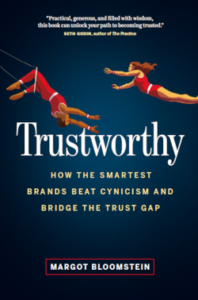 You may resist the idea that as an author you are a brand. It sounds so commercial, so corporate, so corny. But remember publishing is a business, and people buy books based on what they think about an author. Your brand becomes your reputation. “A brand is what other people say about you when you’re not in the room,” Jeff Bezos is credited with saying.
You may resist the idea that as an author you are a brand. It sounds so commercial, so corporate, so corny. But remember publishing is a business, and people buy books based on what they think about an author. Your brand becomes your reputation. “A brand is what other people say about you when you’re not in the room,” Jeff Bezos is credited with saying.
How you present your books to the public and represent yourself as an author IS your brand. Even if you aren’t intentionally creating a brand, you’re still leaving people who currently follow you and your prospective readers with an impression of who you are. It’s in your best interest to become more intentional about branding yourself as an author.
From your dust jacket to your social media efforts, your brand represents you and your book. Your brand helps you cultivate name recognition, but more importantly, it communicates to audiences whether or not you are trustworthy. It’s one thing to write from the perspective of an unreliable narrator in a work of fiction and an entirely different thing to be an unreliable author. Good strategy for the former, lethal for the latter.
![]() For more than a decade it’s been important to include an author head shot in your book proposal. The image you present of yourself is important to aquisitions editors because it’s important to readers. Your photo will be used in all publicity and marketing materials. If you’re the author of a children’s book, and your photo looks like a mug shot of a wanted criminal, you’ll have a hard time landing a contract. If you’re the author of a book about trekking through the wilderness, but your hairdo wouldn’t withstand a drop of rain, then you may not be seen as an authority on your subject. But your brand is far more than your photographic image.
For more than a decade it’s been important to include an author head shot in your book proposal. The image you present of yourself is important to aquisitions editors because it’s important to readers. Your photo will be used in all publicity and marketing materials. If you’re the author of a children’s book, and your photo looks like a mug shot of a wanted criminal, you’ll have a hard time landing a contract. If you’re the author of a book about trekking through the wilderness, but your hairdo wouldn’t withstand a drop of rain, then you may not be seen as an authority on your subject. But your brand is far more than your photographic image.
How can you create an author brand for yourself that is trustworthy? One that readers trust to share a compelling story or convey an authoritative account on a particular subject? Margot Bloomstein’s new book, Trustworthy, offers a three-part framework for you.
Voice, volume, and vulnerability.


Voice is the embodiment of your personality on paper. It isn’t the voice of a fictional character in your novel. It’s your personality as an author. Are you approachable? Is your style snarky or humorous? Do you exude compassion? Strong, clear, and consistent use of your personality in your words helps readers understand who you are and engage with you. Voice is about honesty and clarity. It’s about putting your authentic self out there and having the courage to express who you really are. Voice isn’t something you can learn. It’s not something you can copy. It’s something you find inside yourself. Listen to that inner voice in your head. That’s the one you want to tap into and capture in words. Your voice is like your fingerprint – it’s yours and yours alone.
 Volume doesn’t mean the degree of loudness or the intensity of the sound of your voice. Yelling in all caps is a huge turnoff to readers. Volume means the quantity or amount of information you convey in writing. You want to provide enough detail to convince readers to buy your book. How much is “enough?” Enough is sufficient breadth, depth, and height so they can make an informed decision to purchase your book and feel confident that the author will deliver what has been promised by the available information. Breadth is across many networks or channels of communication so that readers can find you where they are. Depth of information is about how specific you are. It can often be measured by the length of your communications. If it is too general, then your readers won’t be able to understand how your book is distinctive and original and why they should bother reading yours instead of another. But don’t give away so much information that the reader doesn’t feel it’s necessary to read the book. Certainly, you’ve seen movie trailers that have condensed all the significant plot points, so you don’t feel you need to even see the film. Height has to do with writing that reaches for the reader. Do you convey what value your book will have to a reader? Why will the reader be interested in your work? The context will inform how much you need to write. If you are describing your book, one paragraph should be enough. If you are publicizing an event, make sure you communicate when (date and time), where (location and sponsoring bookstore or organization), what (reading, conversation, interview), who (moderator/interviewer, other authors included), and how (registration, RSVP) to participate in the event. If you are answering interview questions, some may only require a short answer while others will require longer ones. Provide enough volume so your readers can confidently make their own decisions.
Volume doesn’t mean the degree of loudness or the intensity of the sound of your voice. Yelling in all caps is a huge turnoff to readers. Volume means the quantity or amount of information you convey in writing. You want to provide enough detail to convince readers to buy your book. How much is “enough?” Enough is sufficient breadth, depth, and height so they can make an informed decision to purchase your book and feel confident that the author will deliver what has been promised by the available information. Breadth is across many networks or channels of communication so that readers can find you where they are. Depth of information is about how specific you are. It can often be measured by the length of your communications. If it is too general, then your readers won’t be able to understand how your book is distinctive and original and why they should bother reading yours instead of another. But don’t give away so much information that the reader doesn’t feel it’s necessary to read the book. Certainly, you’ve seen movie trailers that have condensed all the significant plot points, so you don’t feel you need to even see the film. Height has to do with writing that reaches for the reader. Do you convey what value your book will have to a reader? Why will the reader be interested in your work? The context will inform how much you need to write. If you are describing your book, one paragraph should be enough. If you are publicizing an event, make sure you communicate when (date and time), where (location and sponsoring bookstore or organization), what (reading, conversation, interview), who (moderator/interviewer, other authors included), and how (registration, RSVP) to participate in the event. If you are answering interview questions, some may only require a short answer while others will require longer ones. Provide enough volume so your readers can confidently make their own decisions.
 Vulnerability. Readers need to know you are human, even fallible. They need to know what you stand for: your values and beliefs. Readers want to know that you are concerned about the climate crisis, fear rejections or negative reviews, angry about the sexual discrimination your daughter faces in employment, or feel devastated by the death of your cat. Dr. Brené Brown describes vulnerability as uncertainty, risk, and emotional exposure. When you let your audiences know you are vulnerable, they trust you more, not less. Transparency is important. Even more so is accountability. You must make yourself accountable to your readers if you make a mistake or do something wrong. Take responsibility, make a plan to remedy the situation, and follow through. It’s risky business to expose yourself to readers, and you want to minimize the risks to yourself and your family. It’s not necessary to disclose the names of your children, your home phone number, or local address. But presenting yourself as perfect or superior to your audiences won’t win you any new readers.
Vulnerability. Readers need to know you are human, even fallible. They need to know what you stand for: your values and beliefs. Readers want to know that you are concerned about the climate crisis, fear rejections or negative reviews, angry about the sexual discrimination your daughter faces in employment, or feel devastated by the death of your cat. Dr. Brené Brown describes vulnerability as uncertainty, risk, and emotional exposure. When you let your audiences know you are vulnerable, they trust you more, not less. Transparency is important. Even more so is accountability. You must make yourself accountable to your readers if you make a mistake or do something wrong. Take responsibility, make a plan to remedy the situation, and follow through. It’s risky business to expose yourself to readers, and you want to minimize the risks to yourself and your family. It’s not necessary to disclose the names of your children, your home phone number, or local address. But presenting yourself as perfect or superior to your audiences won’t win you any new readers.
Perhaps the most important lessons for authors from Margot Bloomstein’s new book about becoming trustworthy is that you have to give trust in order to get it. Trust your readers. Trust them not only in your branding efforts but in your efforts as an author.
Leave room for the reader on the page and trust them.
That means taking the “me” out of your memoir. If every sentence uses the pronoun “I,” you exclude the reader from directly experiencing what you describe. Instead of writing, “I walked down the tree-lined street which formed a canopy over my head,” try “Trees lined the street, creating a canopy overhead.” The reader in the second sentence has stepped into your shoes for the direct experience. The reward for reading memoir is that one can know what something was like without having to live it.
That means rewarding readers by eliminating redundant information. Trust that they have read what you’ve already written and don’t assume the reader is incapable of remembering what came before in your manuscript.
 That means your book should not be lecturing at readers. Nobody likes to be lectured or talked down to. Invite the readers into a conversation and assume they can be trusted with the evidence to draw their own conclusions. In short, avoid “telling” and “show” instead.
That means your book should not be lecturing at readers. Nobody likes to be lectured or talked down to. Invite the readers into a conversation and assume they can be trusted with the evidence to draw their own conclusions. In short, avoid “telling” and “show” instead.
Trusting your readers will help them put their trust in you.

I like this sentence: The reward for reading memoir is that one can know what something was like without having to live it.